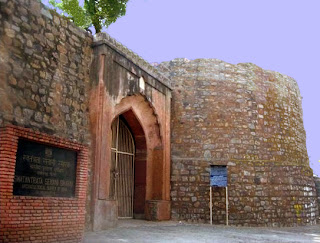Salimgarh Fort was built in 1546 AD, in Delhi, in a former island of the Yamuna River, by Salim Shah Suri, son of Sher Shah Suri. There was a pause in Mughal rule when in 1540 AD Sher Shah Suri defeated the Mughal Emperor Humayun (and ousted him from Delhi) and established the Sur dynasty rule in Delhi. Sur dynasty rule lasted till 1555 AD when Humayun regained his kingdom by defeating Sikander Suri, the last ruler of the dynasty. During the Mughal period, in later years, while building the Red Fort and Shahjahanbad, several Mughal rulers including Emperor Shahjahan who is credited with completing Shahjahanabad in 1639 AD had camped at this fort. It is said that Humayun had camped at this fort for three days before launching his successful attack for recapturing Delhi.
Aurangzeb, the Mughal Emperor, converted the fort into a prison, which practice was perpetuated by the British who took control of the fort in 1857. The Fort is part of the Red Fort Complex.
During the British rule, the Sepoy Mutiny (also called the First War of Independence (the Upraising) was put down in 1857 and the last Mughal Emperor Bahadur Shah Zafar II was taken prisoner at Humayun tomb. This fort was then the scene of lot of war activity. During the Upraising, Emperor Bahadur Shah II‘s complicity with the mutinous soldiers was obvious. He operated from this Fort. During August and early September 1857 he held meetings at the fort on war strategy. He also watched, from the ramparts of the fort, artillery fire aimed at the British Army. He even played a psychological game with his army officers who had come in a delegation seeking salary, when he told them that he would forego some of his crown jewels for the purpose and that he would give up his life for the cause; the officers refused his offer trusting that the Emperor was stating all this in right earnest. Following this, even proclamations were issued declaring that the Emperor would lead the attack against the British and urging all his people, irrespective of caste or creed, to join him in fighting the war. But, in the middle of September 1857, British soldiers were closing in on the Fort. At this stage, his trusted assistant Bhakt Khan urged the Emperor to leave the fort and accompany him to a safer place and look for a day when he could “renew war in the open country”. But the Emperor refused, permitted his army to vacate the fort but he himself moved to the Humayun tomb. The fourth infantry of the British army entered the Salimgarh Fort where they encountered a single sentry only. Similar experience was encountered by the Punjab Fourth infantry regiment when, earlier, they had entered the Palace from the Lahore gate of the Red Fort.


No comments:
Post a Comment